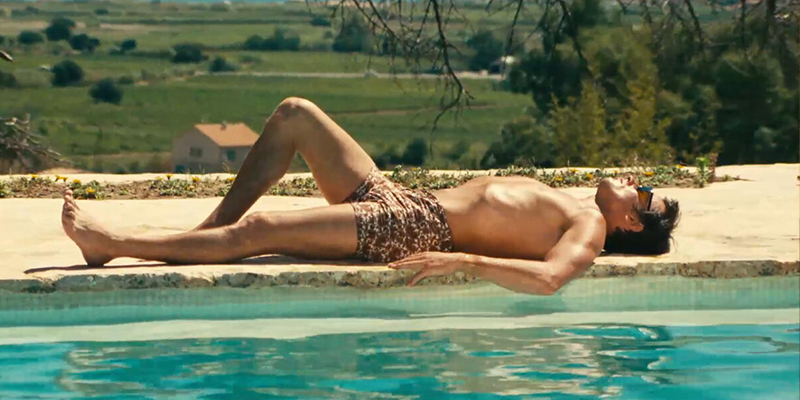You could call it Chekhov’s swimming pool: catch sight of a pristine , turquoise pool in the first act of a noir or crime film, and you’re likely to find a corpse floating in it by the third.
Noir has long had a special relationship to water. As Chinatown makes abundantly clear, whoever controls the water supply controls a city. But unlike the free-flowing ocean or even the trickle of the Los Angeles river, pools are stagnant, claustrophobic. They’re a status symbol. They summon images of luxury, and class, and wealth, and Alain Delon in tight-fitting swim trunks. But pools are also a trap. There’s nowhere for all that water, or those swimmers, to go. There is no escape.
As the summer heats up and we head into pool season, I thought it might be a worthwhile dive into noir film to explore some of the most memorable and deadly pools the genre has to offer—not unlike an online article version of Burt Lancaster in The Swimmer darting from pool to pool to pool, only with slightly fewer Speedos and definitely more dead bodies.
Let’s start with an American classic. While The Great Gatsby is not technically a noir novel according to most high school English teachers, it certainly flirts with the genre, particularly in its last third. Gatsby’s wealth and status do not protect him from closing the novel murdered in a pool. All that wealth, all his striving, and still: he’s facedown in the American Dream. The only thing Fitzgerald could’ve done to hit the nail a little harder on the head would’ve been to throw some of those cool, crisp, money shirts into the pool with him.
Jay Gatsby dead in his little-used swimming pool may have been the original man dead in a puddle of the American Dream, but he was far from the last. Arguably the most famous pool in noir cinematic history—maybe all of cinematic history—is Joe Gillis narrating the start of the story of his own demise in the opening shots of Sunset Boulevard (1951). “The poor dope…always wanted a pool,” Gillis says of himself in a voiceover monologue opening the film. “Well, in the end, he got himself a pool—only the price turned out to be a little high.” The pool is both the end and the beginning of the story here.
By the 1960’s and 1970’s, swimming pool as dark metaphor were popping up all over the movie theater. There’s Dustin Hoffman, slowly sinking his future in chlorine in The Graduate (definitely not a noir, although the dramatic irony of its famous end shot makes you think…maybe?), Burt Lancaster in The Swimmer, and of course, The Drowning Pool, where Paul Newman, as Harper the private investigator, tries to keep his head above literal water in the adaptation of the Ross MacDonald novel.
But perhaps the most influential cinematic swimming pool of this era comes from France: La Piscine, the 1968 psychological thriller directed by Jacques Deray, and starring Alain Delon, Romy Schneider, Maurice Ronet, and Jane Birkin. In La Piscine, the swimming pool represents the erotic lull of summer, so steamy you may feel compelled to wipe your screen off a few times while watching. It’s also the site of a murder—initially passed off as an accident. The Guardian’s 2011 review of the film noted: “Something in the very lineaments of the pool itself creates their own awful destiny: it is a primordial swamp of desire, a space in which there is nothing to do but laze around, furtively looking at semi-naked bodies.”
(In a twist of the “life is stranger than art” variety, Delon’s friend and bodyguard, Stevan Markovic, was found murdered during the course of filming. If you’re unfamiliar, the Markovic Affair, as it became known, makes for fascinating reading: there’s gangsters, alleged kompromat of the First Lady of France, and a still-unsolved murder.)
La Piscine’s sultry mix of psychosexual drama and murder set a template that inspired at least two other films that center around a swimming pool: Swimming Pool, the trippy 2003 film from Francois Ozon and starring Charlotte Rampling and Ludivine Sagnier. Rampling plays Sarah, a crime writer, whose creative retreat to the South of France villa owned by her publisher (and sometime-lover) is interrupted by Sagnier, the publisher’s daughter (or is she?), a sexually voracious young woman whose character was definitely written by a man (or was she?). Once again, the eponymous pool—where Sagnier frequently swims in the nude, which Sarah first encounters as cluttered with debris, perhaps a metaphor for her own writer-blocked state—is also the site of violent death.
Also inspired by La Piscine, perhaps even more directly, was the 2015 film, A Bigger Splash, directed by Luca Guadagnino and starring Tilda Swinton, Ralph Fiennes, Matthias Schoenaerts, and Dakota Johnson. The setting is shifted to Italy, but much of the film’s plot mirrors La Piscine. And to double down on the noir swimming pool motif, the film draws its title from one of David Hockney’s (arguably one of the most noir-coopted artists of the midcentury) famous pools.
By the release of Wild Things in 1998, the swimming pool, where Neve Campbell and Denise Richards tussle and make out (undoubtedly the most famous scene in the film), had become erotic camp. Roger Ebert accurately described the film as “like a three-way collision between a softcore sex film, a soap opera, and a B-grade noir” but I think there’s more to it than that. By this point, the pool in a crime thriller had become shorthand for sexy sleazy summer fare. Like all the best soapy thrillers, Wild Things knows this, and isn’t afraid to take the point to the extreme. This pool isn’t high art; it is almost literally a cesspool.
Sexy Beast, Jonathan Glazer’s 2000 directorial debut starring Ray Winstone and Sir Ben Kingsley, opens with a retired gangster absolutely roasting poolside. The pool is very clearly gangster “Gal” Dove’s retirement treat, a supposed symbol of the luxury he’s now attained, having gotten out of the game. Except if you know anything about noir pools—well, and movies—you know that retirement is about to come to an end. The pool is never, ever a symbol of happily ever after; it’s a destination only for corpses. This turn is perfectly signaled by the film by the introduction of an enormous, immovable boulder crashing into the pool. Gal’s days of danger are, in fact, not over.
Finally, let’s not overlook the great noir pools of television. By the 2000s, several memorable swimming pools would connect premium crime television to the best of the genre. It’s with the ducks in his pool that we open the story of Tony Soprano and his therapy sessions. Despite all of his wealth and power and status, for which the swimming pool is a stand-in, Tony still can’t keep the family of ducks from flying away.
Breaking Bad, too, is full of contaminated pools, standing in for the guilt Walter White is suppressing over his drug kingpin life. In particular, the singed pink teddy bear that falls into Walt’s pool and recurs as a motif throughout season two elegantly showcases Walt’s submerged guilt over the human cost of his actions. Walt’s inability to reckon with how much damage he’s caused eventually begins to drown his family, with his wife Skylar, now Walt’s accomplice, fully walking into the pool in season five.
Splashing around in a pool is one of the high points of summer, if you can swing it. But never forget: murder may smell like honeysuckle, but it tastes like chlorine.

















